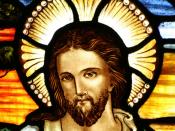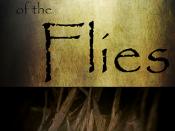Simon, the Christ Figure
References to various religions in novels are made to help the author illustrate to
the reader the situation in which he has placed his characters. In The Lord of the Flies,
William Golding uses biblical allusion to enhance the reader's perspective on the story. In
events and metaphors, the character Simon stands out as the Christ figure, and the Beast
plays the part of the Devil.
As Simon is out walking, he comes across a group of small children trying to reach
fruit hanging from the higher branches of the tree.
Here, the littluns who had run after him had caught up with him. They talked,
cried out unintelligibly, lugged him toward the trees. Then, amid the roar of the
bees in the afternoon sunlight, Simon found for them the fruit they could not reach,
pulled off the choicest from up in the foliage, passed them back to the endless
outstretched hands.
When he had satisfied them he paused and looked round. The
littluns watched him inscrutably over double handfuls of ripe fruit. (56)
In giving them the fruit until they are satisfied, Simon recreates the event in which Christ
multiplied the loaves and fishes to feed the poor until they were contented. After this,
Simon disappears from the others to be alone and begins to have feelings that something is
wrong. He starts to have premonitions of the Beast: The Lord of the Flies.
When the boys set off in a party to find the Beast on the mountain, Simon starts to
see a vision of what they will find.
Simon . . . felt a flicker of incredulity -- a beast with claws that scratched, that sat
on a mountain-top, that left no tracks and yet was no fast enough to catch
Samneric. However Simon thought of the beast, there rose before his inward
sight the picture of a human at once heroic and sick. (103)
Simon has a direct premonition of one of the physical manifestations of the Beast. He
later finds that 'the Beast' is a dead paratrooper. Christ was also known to be a profit and
to predict works of the Devil. Simon predicting the instances of the beast conjures
thoughtful feelings in him, and leads Simon to contemplate his situation through silent
thinking, or meditation.
Before he confronts the beast, Simon meditates as Christ often did: away from
civilization and in the silence of nature. During his meditation, he senses that something is
wrong. His premonitions are right again as the hunting party leaves a present for the
beast, as worshippers leave offerings to the devil.
As Simon investigates this offering of a mutilated pig, he studies carefully the flies
on the spilled entrails of the pig and on the decapitated head of the animal, which is now
stuck up on a pole. The pig's head, another physical manifestation of the beast, begins to
speak to Simon. The beast begins to tempt and threaten Simon, as the Devil had done to
Jesus in the desert.
'There isn't anyone to help you. Only me. And I'm the Beast.' . . . 'This has gone
quite far enough. My poor, misguided child, do you think you know better than I
do?'
There was a pause.
'I'm warning you. I'm going to get angry. D'you see? You're not wanted.
Understand? We are going to have fun on this island. Understand? We are going
to have fun on this island! So don't try it on, my poor misguided boy, or else--'
(143-144)
The temptation offered to Simon is to have fun on this island, to abandon his hopes of
going home, or else. He begins to feel weary and loses consciousness.
When he awakes, he looks around and can see something on the top of the
mountain. On the top, he finds the dead paratrooper. He quickly loses strength, falls
once. and begins to be sick at the sight of the decaying corpse: the truth of the Beast. He
then takes the tangled lines of the paratrooper and sets them free from the rock which
holds them. As he turns around, he sees the entire camp along the beach, with nearly all
of the children there. As he starts down the mountain, he staggers and falls a second time,
as did Christ when he bore his cross, his burden of truth, to the hill. He then begins his
descent.
When Simon comes from the forest to the beach, the hunters are engaged in
dancing worshipfully to the hunt and the hunters, chanting and raving mad. Simon
attempts to talk to them.
A thing was crawling out of the forest. . . . The shrill scream that rose before the
beast was like a pain. The beast stumbled into the horseshoe.
'Kill the beast! Cut it's throat! Spill it's blood!' . . .
Simon was crying out something about a dead man on a hill. . . . The beast was on
it's knees in the center [of the circle], it's arms over it's face. . . . The beast
struggled forward, broke the ring and fell over the steep edge of rock to the sand
by the water. At once the crowd surged after it, poured down the rock, leapt on
to the beast, screamed, struck, bit, tore. There were no words, and no movement
but the tearing of teeth and claws. (152-153)
As Christ died for the sins of the world, so Simon dies for the sake of the rest of the
children. As they believe it is the beast that is dying, the image of the beast is destroyed,
and the children are given relief from a threat that they believed could kill them.
After the children kill him, Simon makes his descent toward the unknown.
On the mountain-top the parachute filled and moved; the figure slid, rose to it's
feet, spun, swayed down through a vastness of wet air, and trod with ungainly feet
on the tops of the high trees falling, still falling, it sank toward the beach and the
boys rushed screaming into the darkness. The parachute took the figure forward,
furrowing the lagoon, and bumped it over the reef and out to sea. (153)
When Christ died, he first descended into the underworld. Simon also decends with the
final fall of the paratrooper. He is dragged off and plummets into the darkness. His body,
having gone down into the unknown, readies for it's ascent.
After Christ's descent, His ascension into heaven followed. Simon has decended
and his own rising now awaits.
The tide swelled over the rain-pitted sand and smoothed everything with a layer of
silver. Now it touched the first of the stains that seeped from the broken body and
the creatures made a moving patch of light as they gathered at the edge. The
water rose farther and dressed Simon's coarse hair with brightness. The line of his
cheek silvered and the turn of his shoulder became sculptured marble. The strange
attendant creatures, with their fiery eyes and trailing vapors, busied themselves
around his head. The body lifted a fraction of an inch from the sand . . . Then it
turned gently in the water. (154)
Just as God rose Christ into heaven, the water rises Simon from the sand to meet his final
resting place. The small creatures which are around his head create the illusion of an aura.
The same aura which manifested itself around Christ's head as he rose to meet his Father
in heaven.
Biblical allusions are made in many novels; the most obvious of which include the
presence of a Christ figure and a representation of the Devil. These references are still a
constant that writers use to help flesh out a plot or sub-plot that, without these references,
readers may not understand. This sort of metaphor explains itself in meaning, and also
explains a great deal to the reader through its usage.


